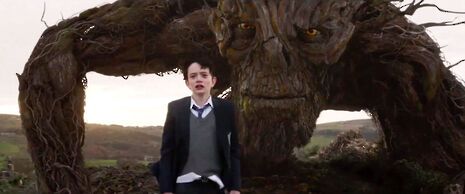Review: Tears are shed when “A Monster Calls”
Danielle Cameron finds herself overwhelmed by J.A. Bayona’s sensitive adaptation of Patrick Ness’s novel

Five years have passed since Patrick Ness’s critically-acclaimed YA novel A Monster Calls was published. However, the story did not start with Ness. It began with an original idea that was passed onto him by fellow children’s author Siobhan Dowd while terminally ill. Now, the story finds a brilliant new form in J. A. Bayona’s sensitively directed adaptation.
“A Monster Calls’s structural simplicity informs a stunning, magical realist yet understated study of grief.”
The story’s structure may seem simple enough: thirteen-year-old Conor (Lewis MacDougall) struggles to acknowledge his own sadness in the face of his mother’s illness. Conor’s unarticulated pain causes the titular monster, an ancient yew tree (voiced by Liam Neeson), to come walking. The monster tells the young boy three tales and demands Conor to tell a fourth – to tell his ‘truth’ – when the time is right. Through Bayona’s treatment, Ness’s screenplay and the cast’s nuanced performances, A Monster Calls’s structural simplicity informs a stunning, magical realist yet understated study of grief.
Akin to his novel, Ness’s screenplay gives no time to unnecessary sentiment or schmaltz. Paired with the complex performances of Felicity Jones and MacDougall as beloved mother and son, Ness’s writing allows a sadness to cut across the film without being smothered by cliché. While the monster’s voice is unmistakably Liam Neeson’s trademark growl, this does not distract, especially when a crucial dualism is revealed. Anyone who has read the original novel will be pleasantly surprised, and intrigued, by the additions that Ness has made in his screenplay. As someone already familiar with the story’s sadness, I thought that I might be emotionally prepared for the film but Ness’s new denouement floored me.
Another narrative tweak between book and screenplay is the heightened role of art in both Conor’s and his mother’s – Lizzie’s – lives. Conor often loses himself in his sketchbook and later finds out from his estranged father that Lizzie had wanted to go to art school. This emphasis on art perfectly complements Adrián García’s exquisite animations of the monster’s tales. While Ness’s novel is inseparable from Jim Kay’s jagged, black and white illustrations so too is Bayona’s film from García’s lush, fluid images. The animations, as well as the tales, lend much-appreciated moments of vibrancy and reprieve from what is otherwise a predominantly bleak film.
Yet, A Monster Calls’s bleakness does not provide its undoing. The film is heavy-going, yes, but its subject matter hardly suggests an easy watch. The first words spoken are: “How does this story begin? With a boy too old to be a kid, too young to be a man”. This exchange captures the essence of A Monster Calls. The cast and creatives’ refusal to succumb to sentiment allows a story to be told that reminds its audience that grief can cause you to simultaneously feel too old and too young to face the road ahead. The beauty in A Monster Calls lies in its ability to tell its audience that, despite this, you can still make it through.
Akin to his novel, Ness’s screenplay gives no time to unnecessary sentiment or schmaltz. Paired with Felicity Jones’s and MacDougall’s complex performances as beloved mother and son, Ness’s writing allows a sadness to cut across the film without being smothered by cliché
 Interviews / ‘People just walk away’: the sense of exclusion felt by foundation year students19 April 2024
Interviews / ‘People just walk away’: the sense of exclusion felt by foundation year students19 April 2024 News / Controversy on the Cam: John’s spend almost 90 times more on rowing than other colleges19 April 2024
News / Controversy on the Cam: John’s spend almost 90 times more on rowing than other colleges19 April 2024 Theatre / The closest Cambridge comes to a Drama degree 19 April 2024
Theatre / The closest Cambridge comes to a Drama degree 19 April 2024 News / Corpus student left with dirty water for over six months21 April 2024
News / Corpus student left with dirty water for over six months21 April 2024 News / Emmanuel College cuts ties with ‘race-realist’ fellow19 April 2024
News / Emmanuel College cuts ties with ‘race-realist’ fellow19 April 2024





